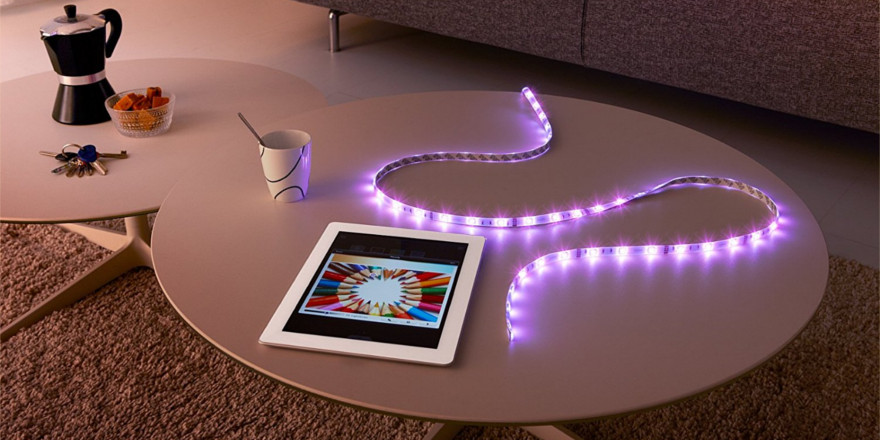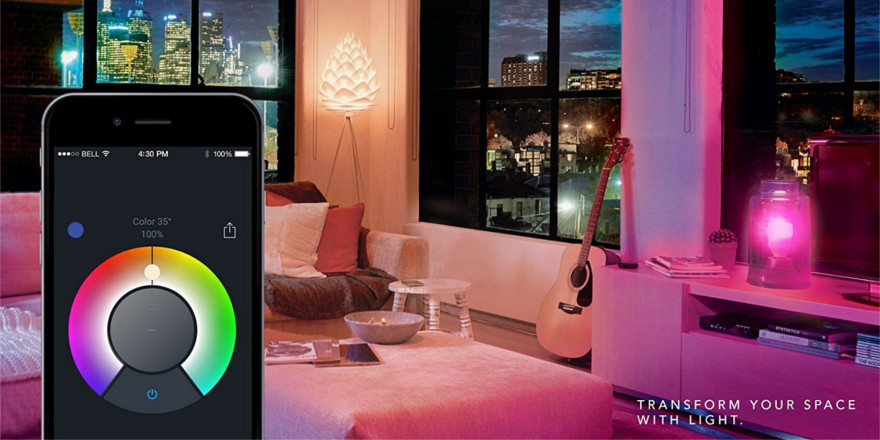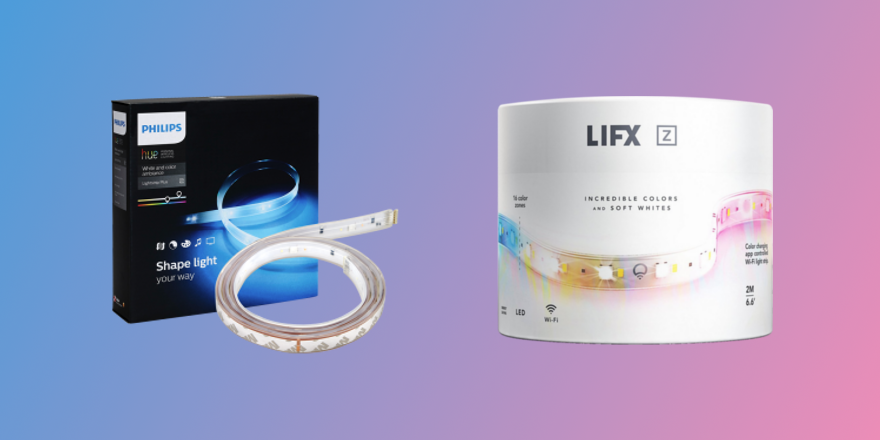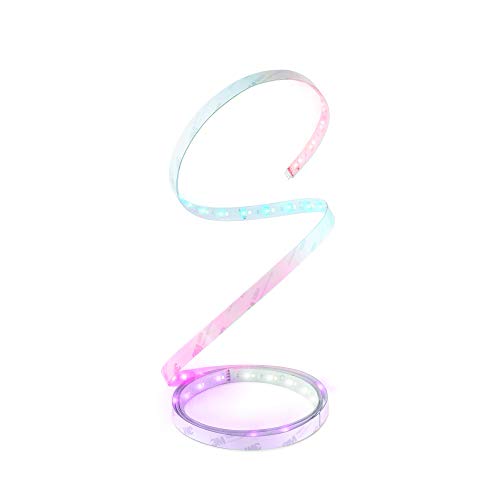Finding the right lighting for your home can be tough task. There are so many spaces where traditional light just doesn’t quite fit. You want something more than functional, and at the right price. Lightstrips are an option away from traditional lamps in the corner of a room or bulbs hanging from the ceiling. And they can provide (offer?) excellent light in areas most can’t even imagine, with added features that only smart lighting can provide.
With so many smart lights to choose from, this article is going to help you to compare and contrast the features of two lightstrips: the Philips Hue Lightstrip Plus vs. LIFX Z. We’ll take a look at the features and differences to help guide you on the better choice for your home.
Both products are fantastic for under cabinets, television stands, computer desks, and basically anywhere your imagination says, “Yeah, lighting there would be a huge plus.” After going over the differences, we’ve put together a table that will show the products and their features side-by-side, followed by a sort of wrap up. So, with that all said, let’s look at both the Philips Hue Lightstrip Plus and the LIFX Z.
LIFX Z vs. Philips Hue Lightstrip Plus – Differences

-
Difference #1: Bridge – The most glaring difference is that the Philips Hue Lightstrip Plus requires a Philips Hue Bridge to work. You can buy it separately or, if you’re looking for smart bulbs to go with your lightstrip, get the bridge as a part of a Philips Hue White and Color Light Bulbs Starter Kit. One Philips Hue Bridge can support up to 63 bulbs, but the system becomes less responsive connecting more than 50.
As for LIFX, just like LIFX light bulbs, the LIFX Z lightstrip doesn’t need a hub or bridge to work. You just plug in the lightstrip, download the LIFX app, and you’re good to go.
For this difference, we easily side with LIFX Z — Less on the wallet, and easy to get started. However, if you plan on expanding your smart home lighting, the Philips Hue collection might be the route to go, as they offer smart bulbs, dimmers, and motion sensors.
-
Difference #2: Brightness and Light Quality – Oh! And could there possibly be a more important aspect for lighting than brightness and quality? Lighting, no matter how pretty or flashy, still has to provide its function to be worth the cost.
The LIFX Z lightstrip provides extremely vivid and accurate colors when compared to the Philips Hue Lightstrip Plus. What’s even better is that the LIFX Z lightstrip gets brighter as it’s extended! The LIFX Z offers 1,400 Lumens per two meters. With every added extension, the overall lumen output of the strip goes up 700 lumens. There is a limit though: 2,800 lumens max per light strip. And it’s way above what the Philips Hue Lightstrip Plus offers, which is 1,600 lumens no matter the amount of extensions you add.
So if you’re looking for bright and vivid colors, LIFX Z lightstrip is definitely the one to go with.
-
Difference #3: White Light Tones – Both the Philips Lightstrip Plus and LIFX Z lightstrip offer warm and cool whites to help set the tone of a home. Different white tones are great for different activities. The warm white lighting is perfect for reading or relaxing, whereas natural/cool white light can energize you and help you concentrate. And even though both lightstrips offer similar white tones, the LIFX Z strip features a wider white temperature range of 2,500 to 9,000K vs. Philips Hue’s 2,500 to 6,500K. The Philips Hue just doesn’t have access to those deeper, colder colors of white light — so we’d give LIFX Z the edge on this one.
-
Difference #4: Zone Control – The LIFX Z lightstrip is the only strip to offer zone control. The lightstrip has 8 color zones per meter. You can customize each zone with different color. You can express your creativity and accent your home’s decor with customizable color zones.
Unfortunately the Philips Hue Lightstrip Plus doesn’t have this feature, but who knows, they might add zoning to their next generation of lightstrips.
-
Difference #5: Apps – You can control your Philips Hue lights via their app which works on both iOS and Android. LIFX, on the other hand, offers more integration with smartphones. The LIFX app is available for iOS, Android, and Windows 10 phones. So if you have a Windows 10 smartphone, the choice for you is pretty obvious.
We compared both Philips Hue and LIFX apps, and hands down our choice goes in favor of LIFX. The LIFX app has a wonderfully intuitive, user-friendly design which makes it easy and fun to use. Plus, it has some advanced features already built into the app, so you don’t need to use other third-party apps. Which leads us to the next difference.
-
Difference #6: Music Syncing – Both Philips Hue and LIFX offer music syncing as one of their advanced features. However, if you want to sync your Philips Hue lights with music, you need to get a third-party app: Hue Disco, which is not free.
Again, the LIFX has the music syncing feature already built into their app and you can use it for free. No need to download other apps or pay extra for advanced features.
-
Difference #7: Smart Home Compatibility – When it comes to smart home integration, Philips Hue offers more options than LIFX. So if you plan to add other smart home products to your home, this difference might be very important.
Philips Hue is compatible with Wink and SmartThings hubs, plus it offers integration with Amazon Alexa (Echo, Echo Dot, Echo Show), Google Assistant, Apple HomeKit, Logitech, and Nest.
LIFX is compatible with SmartThings hub, and it offers integration with Amazon Alexa (Echo, Echo Dot, Echo Show), Google Assistant, Logitech Pop, and Nest — Which is a little bit limited when compared to Philips Hue. But, on a good note, you can use IFTTT service with both Philips Hue and LIFX.
And if you’re new to smart home integration, check out our Smart Home Starter Kit article to learn about different smart home products and how to integrate them effectively.
-
Difference #8: Length – When looking into lightstrips, an important feature is length — and being able to adjust that length. Adjusting the length of a lightstrip helps you find, and plan for, more places you can fit lighting.
The Philips Hue Lightstrip Plus comes in one 78.7 inch strip, which is cuttable every 12.9 inches. Once you cut the strip to the desired length, the remaining piece will not light. Though, there are some amateur guides on how to reuse the cutting segments. So if you’re looking to light an area with less than 79 inches of space available, the Philips Hue Lightstrip Plus gives you the option of cutting the strip to fit the space perfectly.
The LIFX Z Starter Kit, on the other hand, has two 1 meter (39.3 inch) strips that you can use to light your home. While both strips together are about as long as the Philips Hue Lightstrip Plus, they are not as individually versatile; the LIFX Z strips don’t have any “cut here” sections, though they still can be cut at your own risk. But be warned: LIFX doesn’t warranty strips that have been cut. What LIFX does offer is a cutting guide on their LIFX support forum, if you’d like to chance it.
Now, in addition to length, and adjusting it, Philips Hue also offers 3.3 feet extensions which you connect directly to the main strip. And, if you’re looking to have multiple sections of lightstrip in a room without having them all in one continuous strip, check out these extension cables for the Philips Hue Lightstrip Plus — The cables let you spread the lighting out across an area.
LIFX also offers lightstrip extensions for the LIFX Z. Unfortunately, they only connect straight into the main lightstrip, thus creating a long strip. Extensions can be added to the main lightstrip to create a length total of 33 feet. So, let’s say your project includes lighting up two separate cabinets, you’ll either end up having a long, one-piece strip connecting the cabinets, or buying two sets of LIFX Z lightstrip kits. Or, with the Philips Hue Lightstrip Plus, you’ll have to purchase extension cables in order to cover the area between the cabinets.
Overall, Philips Hue lightstrips offer safer, more manageable lengths. Plus, it’s reported that Philips Hue lightstrips are easier to bend to fit the corners than the LIFX Z lightstrip. So, whether you’re looking for one lengthy piece or a bit more versatility is completely up to you.
-
Difference #9: Dimensions – Besides length, the LIFX Z Starter Kit and the Philips Hue Lightstrip Plus have a few slight differences when it comes to width and height.
The Philips Hue Lightstrip Plus is thin when it comes to width, at 0.59 in. It’s also short when it comes to height at 0.19 inches, as it should be — you don’t want it taking up more space than necessary to light your home.
The LIFX Z Starter Kit, on the other hand, has very similar widths and heights, though it is slightly smaller: 0.16 inches in height and 0.47 inches in width. Which is not a huge difference, but we feel like it’s worth mentioning.
-
Difference #10: Cost – The two products cost almost exactly the same on the surface. However, the cost of the Philips Hue Lightstrip Plus doesn’t cover the Philips Hue Bridge, which you’ll need to buy separately, unless you already have a Philips Hue system in place.
The LIFX Z Starter Kit has everything you need for it to work right out of the box with no additional purchases necessary.
LIFX Z vs. Philips Hue Lightstrip Plus — Full Charts
| LIFX Z | Philips Hue Lightstrip Plus | |
|---|---|---|
| Energy Cost | 17W | 20.5W |
| Lumen Output | 2,800 Lm. (at max.) | 1600 Lm. (at max) |
| White Color Spectrum | 2,500 to 9,000K | 2,500 to 6,500K |
| 16 million colors | Yes | Yes |
| Zone Control | Yes | No |
| Length | 6.6 Ft. | 6.6 Ft. |
| Extendable | Yes (up to 32 Ft.) | Yes (up to 32 Ft.) |
| Lifespan (in hours) | About 25,000 | About 20,000 |
| Apps | iOs, Android, Windows 10 | iOS, Android |
| Software Upgradeable | Yes | Yes |
| Requires a hub to work | No | Yes |
| IFTTT | Yes | Yes |
| Amazon Alexa | Yes | Yes |
| Google Home | Yes | Yes |
| SmartThings | Yes | Yes |
| Wink | No | Yes |
| HomeKit | No | Yes |
| Free Music Sync | Yes | No |
LIFX Z vs. Philips Hue Lightstrip Plus — Our Thoughts

This article is long, so we’ll keep this short. If you’re looking for a more connected home, and are thinking of expanding your smart home lighting to dimmers, lamps, bulbs, and motion sensors, the Philips Hue Lightstrip Plus is for you. Plus, Philips Hue offers flexible installation options, which include the use of extension cables and the ability to bend the lightstrips up to a 90 degree angle.
But, even though the LIFX Z lightstrip isn’t as versatile when it comes to installation, it offers brighter colors, free music synchronization, a Windows 10 app, zone control, and deeper white tones.
So this really comes down to a quality vs. integration question: if you’re looking for better quality and less to get started, we’d say go with the LIFX Z; if you’re looking to expand your smart home system, we’d say go with the Philips Hue Lightstrip Plus.
Both brands are reputable, and both lightstrips are fantastic — but their use case is entirely up to your needs. Hope this has helped. Let us know your thoughts on the lightstrips in the comments below.
Last update on 2024-04-19 at 09:13 / Affiliate links / Images from Amazon Product Advertising API






Just wanted to say make sure your wireless network is absolutely solid. I wound up returning the lifx strip since I couldn’t get it to work with only my ISP router. There are some pitfalls of you don’t have an additional router on top of your ISP.
Your comparison of the light output (lumens) for these two products does not provide standardized units, and therefore does not allow the reader to know which product truly has the better light output. For this information to be useful to the reader, you must present the output in lumens as ” number of lumens per unit of length”, such as lumens per foot, or lumens per meter. This would be all the more so to clarify your highly confusing explanation of the increased output of the LIFX Z with increased length. Is it brighter simply because there are more lights, or because the lumens per foot (or per meter or whatever) increases?
The LIFX Z offers 1,400 Lumens per first two meters, which increases up to 2,800 Lumens max when extended. With every added extension, the overall Lumen output of the strip goes up 700 Lumens.
The Philips Hue Lightstrip Plus, on the other hand, offers 1,600 Lumens per first two meters and increases up to 1,650 lumens max when extended beyond 2 meters; it basically means that the LIFX Z gets way brighter than Philips Hue Lightstrip Plus when extended.
Why Philips Hue Lightstrip Plus remains almost the same Lumen output when extended? — Well, that’s a good question to ask Philips Hue 🙂